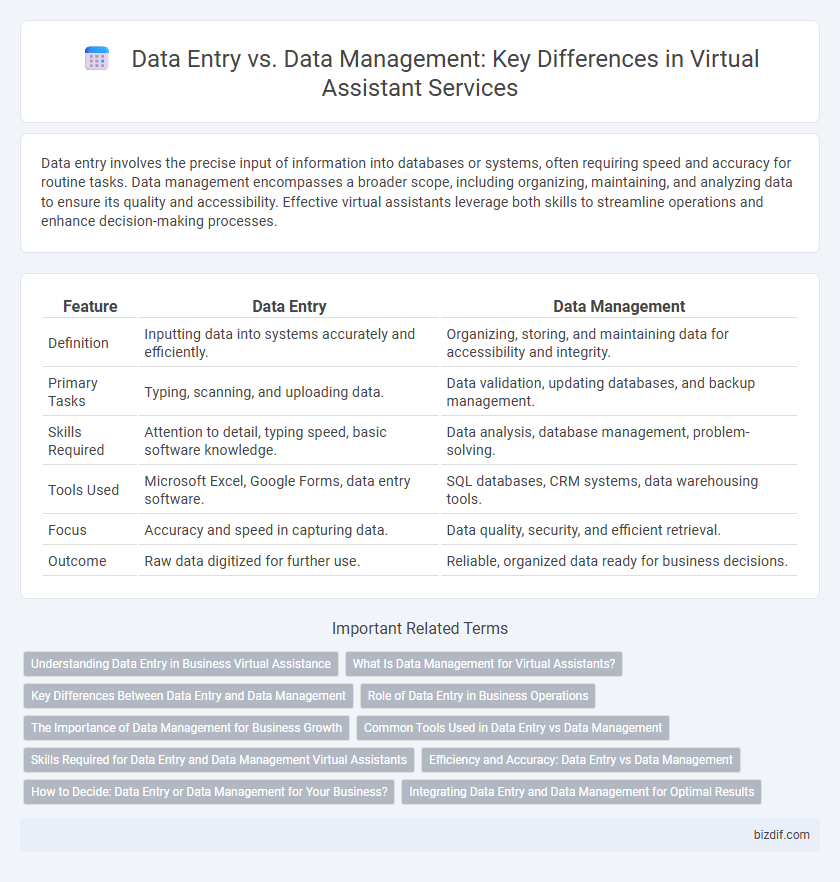Data entry involves the precise input of information into databases or systems, often requiring speed and accuracy for routine tasks. Data management encompasses a broader scope, including organizing, maintaining, and analyzing data to ensure its quality and accessibility. Effective virtual assistants leverage both skills to streamline operations and enhance decision-making processes.
Table of Comparison
| Feature | Data Entry | Data Management |
|---|---|---|
| Definition | Inputting data into systems accurately and efficiently. | Organizing, storing, and maintaining data for accessibility and integrity. |
| Primary Tasks | Typing, scanning, and uploading data. | Data validation, updating databases, and backup management. |
| Skills Required | Attention to detail, typing speed, basic software knowledge. | Data analysis, database management, problem-solving. |
| Tools Used | Microsoft Excel, Google Forms, data entry software. | SQL databases, CRM systems, data warehousing tools. |
| Focus | Accuracy and speed in capturing data. | Data quality, security, and efficient retrieval. |
| Outcome | Raw data digitized for further use. | Reliable, organized data ready for business decisions. |
Understanding Data Entry in Business Virtual Assistance
Data entry in business virtual assistance involves accurately inputting, updating, and organizing raw data into digital systems, ensuring information is correctly captured for operational use. Unlike data management, which encompasses broader tasks like data analysis, optimization, and governance, data entry is foundational, enabling seamless workflow and timely decision-making. Efficient data entry supports business intelligence by maintaining data integrity and accessibility within customer relationship management (CRM) systems, spreadsheets, and databases.
What Is Data Management for Virtual Assistants?
Data management for virtual assistants involves organizing, storing, and maintaining digital information to ensure accuracy, security, and accessibility. Unlike basic data entry, which focuses on inputting information, data management encompasses data validation, categorization, and regular updating to support informed decision-making. Effective data management enhances workflow efficiency and enables virtual assistants to provide comprehensive support in handling complex data systems.
Key Differences Between Data Entry and Data Management
Data entry involves the manual input of raw data into computer systems, focusing primarily on accuracy and speed in recording information. Data management encompasses a broader scope, including data storage, organization, maintenance, and ensuring data quality for analysis and reporting. The key differences lie in data entry's role as a foundational task versus data management's strategic function in optimizing data usability and security.
Role of Data Entry in Business Operations
Data entry plays a crucial role in business operations by accurately inputting essential information into digital systems, enabling efficient data processing and retrieval. This foundational task ensures the integrity and accessibility of records, supporting decision-making and workflow continuity. Effective data entry minimizes errors and streamlines operations, directly impacting overall productivity and organizational success.
The Importance of Data Management for Business Growth
Effective data management ensures accurate, organized, and accessible information, which drives informed decision-making and operational efficiency. Businesses leveraging robust data management practices can identify trends, optimize workflows, and enhance customer experiences, leading to sustained growth. In contrast, mere data entry without strategic management risks inconsistencies and lost opportunities, highlighting the critical role of comprehensive data management in scaling business success.
Common Tools Used in Data Entry vs Data Management
Data entry commonly relies on tools like Microsoft Excel, Google Sheets, and basic form software designed for input efficiency and accuracy. Data management utilizes more advanced platforms such as SQL databases, Microsoft Access, and enterprise software like SAP or Oracle for storage, retrieval, and complex data analysis. Understanding the specific tools enhances productivity by aligning tasks with the appropriate software capabilities in virtual assistant roles.
Skills Required for Data Entry and Data Management Virtual Assistants
Data entry virtual assistants require strong typing skills, attention to detail, and proficiency in software like Microsoft Excel and Google Sheets to accurately input information. Data management virtual assistants need advanced analytical abilities, expertise in database systems, and skills in data organization, validation, and reporting tools such as SQL and data visualization software. Both roles demand excellent time management and communication skills to ensure data accuracy and efficient workflow.
Efficiency and Accuracy: Data Entry vs Data Management
Data entry focuses on inputting information quickly and accurately, maximizing efficiency by reducing errors during initial input. Data management encompasses organizing, storing, and maintaining data to ensure ongoing accuracy and accessibility across systems. Combining efficient data entry with robust data management processes enhances overall data reliability and operational productivity.
How to Decide: Data Entry or Data Management for Your Business?
Choosing between data entry and data management depends on your business's scale and complexity of data processes; data entry involves inputting raw data accurately and quickly, while data management encompasses organizing, maintaining, and analyzing data for strategic decision-making. Businesses with high volumes of structured data requiring routine updates benefit from skilled data entry specialists, whereas companies needing comprehensive data oversight and analytics gain more from data management systems or professionals. Assess your operational needs, data workflow, and long-term goals to determine if focusing on efficient data entry or robust data management will optimize your business performance.
Integrating Data Entry and Data Management for Optimal Results
Integrating data entry with comprehensive data management enhances accuracy and efficiency by ensuring seamless data validation, storage, and retrieval processes. Leveraging automated data entry tools alongside robust management systems minimizes errors and accelerates workflow, driving better decision-making. This holistic approach supports scalable, data-driven operations essential for virtual assistants managing dynamic information environments.
Data entry vs Data management Infographic

 bizdif.com
bizdif.com